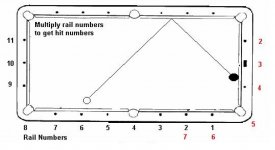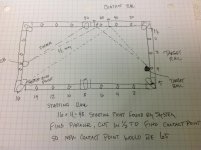Hi again, I can't thank enough everyone for their time here.
Sorry I'm not good with uploading diagrams and I have caused some confusion, the Sid system is not what I'm looking for, first contact rail is the opposite long one.
I just returned from pool hall and after discussion with a couple of good players I have found what I'm looking for, I will try to draw it and upload it asap.
When you have your CB at a corner pocket (80) you aim at 40 on the opposite long rail to reach the corner pocket on the long origin rail.
As you move along the short cushion you establish reference lines by 10ths every 1/2 diamond (90 to 45 at opposite long rail is the first one) and if you wish to reach an obgect ball at 6 diamonds away from your starting long rail you just add 20 (2 diamonds away from 80 to 40 corner) and divide by 2 (so target point at opposite long rail is 55.
Keeping the same reference lines at origin short rail you add 5,10,15 for every diamond desired arrival at opposite short rail and divide again by 2.
Minor adjustments will be needed as you move closer to the target rail.
I'll try to come back with a drawing, it has been such a pleasure having this exchange of opinions, that's a really nice part of the game we all love.
Thank you all so much!!
Petros
Sorry I'm not good with uploading diagrams and I have caused some confusion, the Sid system is not what I'm looking for, first contact rail is the opposite long one.
I just returned from pool hall and after discussion with a couple of good players I have found what I'm looking for, I will try to draw it and upload it asap.
When you have your CB at a corner pocket (80) you aim at 40 on the opposite long rail to reach the corner pocket on the long origin rail.
As you move along the short cushion you establish reference lines by 10ths every 1/2 diamond (90 to 45 at opposite long rail is the first one) and if you wish to reach an obgect ball at 6 diamonds away from your starting long rail you just add 20 (2 diamonds away from 80 to 40 corner) and divide by 2 (so target point at opposite long rail is 55.
Keeping the same reference lines at origin short rail you add 5,10,15 for every diamond desired arrival at opposite short rail and divide again by 2.
Minor adjustments will be needed as you move closer to the target rail.
I'll try to come back with a drawing, it has been such a pleasure having this exchange of opinions, that's a really nice part of the game we all love.
Thank you all so much!!
Petros
Last edited:
![CropperCapture[52].jpg CropperCapture[52].jpg](https://forums.azbilliards.com/data/attachments/210/210329-5ffcea4f6f135a7c16123bc9535cf768.jpg?hash=X_zqT28TWn)

